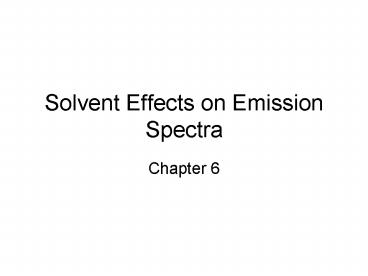Solvent Effects on Emission Spectra - PowerPoint PPT Presentation
1 / 19
Title:
Solvent Effects on Emission Spectra
Description:
Spectral shifts solvent polarity increases energy of excited state decreases ... Hexane no dipole moment small value for orientation polarizability, near 0, ... – PowerPoint PPT presentation
Number of Views:947
Avg rating:3.0/5.0
Title: Solvent Effects on Emission Spectra
1
Solvent Effects on Emission Spectra
- Chapter 6
2
Overview
- Spectral shifts solvent polarity increases
energy of excited state decreases - Lippert Equation accounts for solvent polarity
effects - Fluorophore-solvent interactions
- Charge separation in excited state
3
Jablonski Diagram
- Emission occurs at longer wavelengths than
excitation - Dynamic processes which occur following
absorption - Larger dipole moment in excited state
- Solvent dipoles reorient around excited dipole
more polar solvent this affect increases - Polar fluorophores are sensitive to solvent
polarity - Emission from solvent relaxed state
4
(No Transcript)
5
Polarity Surrounding Membrane Bound Fluorophore
Determine dielectric constant of membrane bound
fluorphore DOS sensitive to solvent polarity
calibrate polarity in different solvents DOS
binding site in membranes non polar
environment Larger charge separation in excited
state enhances sensitivity
6
Mechanisms of Spectral Shifts
Specific solvent interactions lower energy of
excited state. Hydrogen bonding to ethanol (5
solution) Internal Charge Transfer (ICT) or
Twisted ICT solvent affects what state is
lowest energy state (electron donor and acceptor
groups). TICT occurs when rotation of groups on
the fluorophore form TICT state
7
Lippert Equation
?A and vF are the wavenumbers of absorption and
emission h is Plancks constant, and c is the
speed of light, a is the radius or cavity in
which the fluorophore resides
8
- Increase n decrease energy loss
- Increase ? larger difference between vA and vF
- Refractive index ground and excited state
instantaneously stabilized by movements of
electrons within the solvent. Little affect on
Stokes shift - Dielectric constant occurs after reorientation
of the solvent dipoles, movement of solvent
molecules, time dependent. Solvent relaxation is
complete prior to emission
9
Solvent Effects on Stokes Shift
- Hexane no dipole moment small value for
orientation polarizability, ?? near 0, shifted by
at least vibration energy , 1500 cm-1 - Methanol because highly polar - orientation
polarizability causes larger stokes shift
10
(No Transcript)
11
- TNS probe polarity sensitive estimate
polarity of binding site on macromolecules - 200-fold enhancement in QY when bound to BSA
- Linear Lippert Plots solvent effects dominate
- Attachment of phenyl ring to amino group
increases sensitivity to solvent polarity
12
Phase Transition in Membranes
Prodan - Solvent sensitive probe Generalized
Polarization (GP) IB IR / IB IR
13
- Specific Chemical Effects
- Chemical properties of fluorophore
- Local interactions of fluorophore with other
chemical groups - Chemical properties of solvent
- 2-AN new spectral component, Hydrogen bonding
to ethanol creates new component
14
Temperature Effects
- Solvent relaxation occurs faster than the
lifetime observe relaxed state - Solvent relaxation occurs slower than lifetime
observe unrelaxed state - If at equilibrium observe a mixture
15
Examples of Temperature Effects
- NATA lifetime independent of temp.
- Solvent relaxation is temp. dependent
- At low temp emission is observed from unrelaxed
state - Hydrogen bonding from propylene glycol persist
at low temperature
16
Examples in Biochemistry and Biology
- Shift in Acrylodan-labeled actin fluorescence
upon actin polymerization - Fluorescence decrease as well as spectral shift
- Ratio of fluorescence intensities can measure
degree of polymerization
17
Fatty Acid Binding
- Spectral shift in acrylodan-labeled Fatty acids
when bind to FABP - Acrylodan shifts from hydrophobic core of FA to
solvent exposure upon binding
18
Polarity of Membrane Binding Site
- 2-AA, where anthrol group is should be buried in
the membrane - Incorporation into Egg PC vesicles - Probe is in
a relatively polar region of the membrane - Hydrogen bonding may play a role in spectral shift
19
Effects of Shear Stress on Membrane Viscosity
- Viscosity Sensitve Probes
- Differential labeling of the cytoplasm and cell
membrane - As increase viscosity decrease in fluorescence
- Some probes have an enhancement in fluorescence
when viscosity increases - Reduced rotational motion of probe increases
quantum yield































